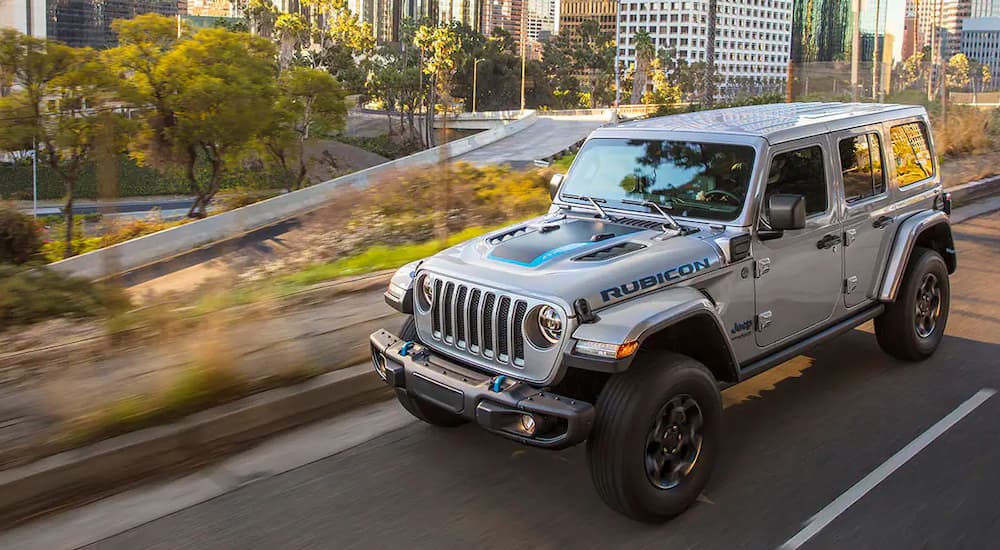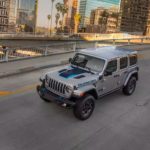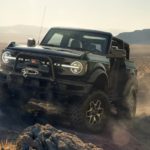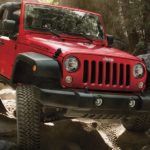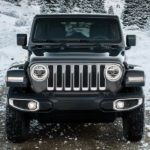By now, you have probably heard the news that there’s a new Wrangler on the prowl. Like many vehicles in the industry, the Wrangler received its eco-friendly upgrade for the 2021 model year in the form of the Wrangler 4xe, a plug-in hybrid variant, and if you’re interested in learning more, you’ve come to the right place. Electric and hybrid vehicles are steadily taking over roadways. As more automakers are designing more impressive green options, more drivers are choosing to make the switch, and no matter where your Jeep dealership is, the Wrangler 4xe is coming. Electric and hybrid vehicles are the wave of the future, so can they compete with their gas-powered counterparts? Let’s take a ride in the Wrangler and the Wrangler 4xe to learn more about the characteristics they share and how the 4xe plans to stand out on its own.
How They’re Similar
Aside from displaying the same name on their rugged exteriors, the Wrangler and the Wrangler 4xe share many of the same features. Not only do they both deliver a solid ride from a respectable brand, they are also made to explore. It’s no secret that Jeep designs some of the most capable vehicles to have ever traversed the trails, desert, rocks, and mud, and when the 4xe was first introduced, some were skeptical, but many believed in the Jeep name.
Let’s start with capabilities. Although the Wrangler and the Wrangler 4xe have different components under the hood, they’re both able to tow up to 3,500 lbs, which is helpful, especially when it’s time for an adventure. In addition, they both provide drivers with the assurance they need when traveling in even the most treacherous environments. Offered in a number of trims to appeal to many different types of drivers, like the famous Rubicon, both the Wrangler and the Wrangler 4xe give the people what they want in an adventure vehicle.
Keeping with the Rubicon model, both the Wrangler and its hybrid sibling provide drivers with an off-road ruggedness that can’t be denied in the form of 33-inch all-terrain tires, high ground clearance, as well as a Rock-Trac Transfer Case for optimal crawling capabilities. The Wrangler and Wrangler 4xe also turn out many of the same numbers when it comes to capabilities, like water fording, for example, as the classic Wrangler and its hybrid version are both able to ford up to 30 inches of water. They also occupy the same ground clearance of 10.8 inches.
You’ll also find that both the Wrangler and the 4xe have much in common when it comes to off-roading mechanics. Tru-Lock electronic locking differentials on the front and rear axles for impressive traction control, as well as an Electronic Sway Bar Disconnect System for added suspension, can be found in both remarkable machines. In addition to some slight differences cosmetically, the overall look of both the Wrangler and the Wrangler 4xe is very similar. Couple this with many of the shared off-road elements found in each, and you’ll see that these two Jeep models share more than you may realize. Although much of what you see is the same, how these two models operate and perform is a whole different story.
How They’re Different
For starters, the Wrangler 4xe is a hybrid, combining a gas engine with an electric motor, which is the biggest difference between the two Wranglers. It’s equipped with a 2.0L I4 DOHC direct-injection Turbo PHEV engine paired with a 17-kWh lithium-ion battery, which work together to provide the Wrangler 4xe with 375 horsepower. The classic Wrangler is available in a number of powertrains to choose from, which is a plus for many drivers, including its strong 3.6L Pentastar V6 with eTorque, which provides the Wrangler with a max horsepower of 285, a significantly lower number than its hybrid counterpart. Torque is where the Wrangler 4xe pulls away from its gas-powered sibling. With 470 lb-ft of torque in the 4xe, compared to the 442 lb-ft that you’ll find with the Wrangler’s 3.0L EcoDiesel V6, the 4xe showcases expert performance, especially when climbing steep hills, utilizing less energy than the standard Wrangler.
Although the Wrangler 4xe is a pro at climbing, another big difference between this model and the original is weight. The Wrangler 4xe is much heavier than the traditional Wrangler, weighing in at 5,222 lbs (Rubicon model) to the original Wrangler Rubicon, which sits at 4,449 lbs, which can vastly impact off-roading activities, so this is important to keep in mind. The differences keep on coming, especially as you compare fuel efficiency ratings, and you can only imagine how much the 4xe dominates this area. Getting an estimated 22 MPG in the city and 29 MPG on the highway with its most efficient engine, the EcoDiesel V6, the Wrangler just can’t hold a candle to the Wrangler 4xe’s estimated 49 MPGe equivalent.
As far as the ride goes, the 2021 Wrangler offers a number of selectable drive modes, like Snow, Sport, Sand/Mud, and more, to help traverse different types of terrains, whereas the plug-in hybrid model offers something completely different. Hybrid mode is the default mode, allowing the Wrangler 4xe to operate by utilizing its electric power, then switching to gas, while Electric mode is available once the battery has more than a 1% charge for minimal tailpipe emissions. eSave mode puts to use its engine, saving the battery for later, and when energy demand is lower, prioritizes its battery for maximum efficiency.
As far as design is concerned, like we mentioned above, there are more similarities than differences; however, there are a few elements that set the Wrangler 4xe apart from the Wrangler. Blue hues dominate the Wrangler 4xe in the form of blue tow hooks and blue badging throughout, as well as blue color palettes that join the lineup of available color schemes. All in all, overall performance and genetic makeup are the main differences between these two fearless travelers. When it comes to off-road capabilities, the Wrangler 4xe proves that hybrids have what it takes to run with the big dogs on the trails and beyond.
A Ride in the Wrangler and the Wrangler 4xe
Upon first glance, it may take you a minute to figure out which is the traditional Wrangler and which is the plug-in hybrid model. Both exude considerable confidence on the road and off, and both showcase that famous Jeep style that we have come to know and love over the decades. Once these two fierce machines get going, it’s evident that they both have immense potential, navigating treacherous terrain with finesse like no other. Plus, when it comes to capabilities, the Wrangler and the Wrangler 4xe can deliver an impactful performance full of energy, power, and all-out prowess in any situation.
Of course, there are many differences between the two, mainly how they operate. Taking a ride in the Wrangler, you’ll find that it’s much louder than its hybrid counterpart, and there’s less power, even coming out of its strongest engine. This can be a surprise to many who believe the stereotype that hybrids aren’t as powerful as gas-powered vehicles. As far as efficiency is concerned, there’s no competing with the Wrangler 4xe, and one ride in this new Jeep model will show anyone that hybrids are capable of more. The Wrangler 4xe seeks to break down the walls that confine many hybrid vehicles, showing the masses what they’re really capable of on the road and beyond, while the Wrangler continues to offer classic Jeep power and capabilities making both exceptional offerings in the Jeep lineup of vehicles.
